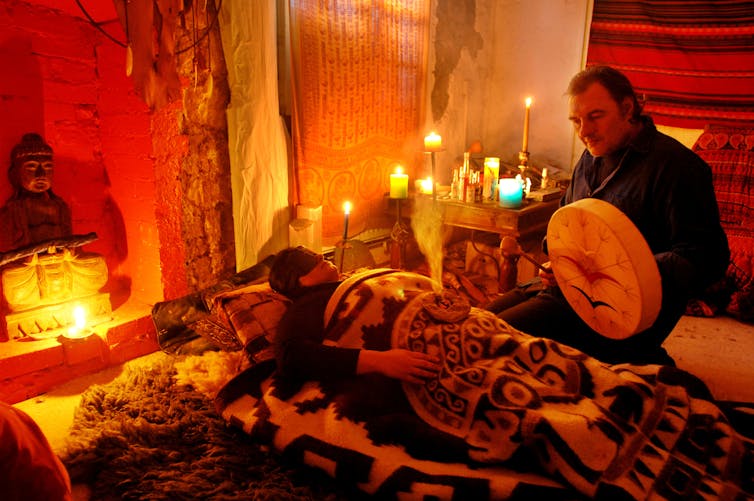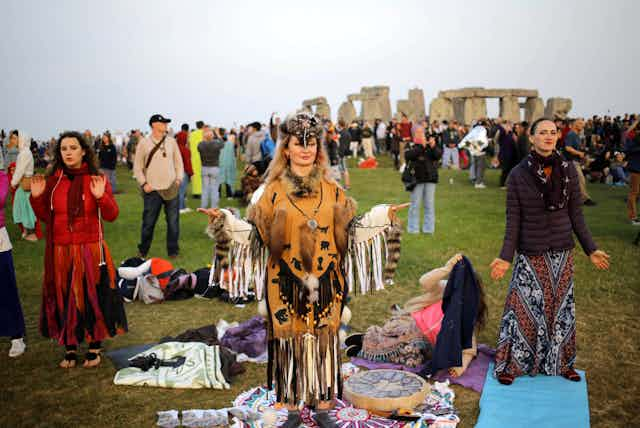According to the latest census, an unlikely “religion” is growing in popularity across England and Wales: shamanism. Just 650 people said they subscribed to the belief system in 2011, but that figure has increased more than tenfold over the past decade to 8,000 people in 2022. This makes shamanism the countries’ fastest-growing religion. So what exactly is it?
Although not an organised religion, shamanism has been around for thousands of years. We don’t know the exact place or moment that shamanism entered human consciousness, but we do know that it has inspired our art, technology and medicine.
It has been found in Australia, Siberia, Korea and throughout the Americas, and is claimed as the root of some religions such as the Bon form of Buddhism, which is found in Tibet.
While the phenomenon is known by many different names and origin stories depending on which part of the world you encounter it, what remains the same is the human desire to connect with the earth, the stars and ultimately “that which is greater than ourselves”.
And while shamanism lives in the realm of religious experience, it simultaneously defies becoming an organised religion by the uniqueness of the experiences of the individuals who practise it.
What is shamanism?
To understand shamanism, it’s important to first understand the worldview that underpins it. The shamanic view of the world is organised into different yet equal parts: the earth or physical world, the human world, and the stars or cosmic world.
Each of these worlds is considered to have its own spirit, and it is with these spirits that a shaman or shamanic practitioner is said to communicate. While this worldview is passed down from generation to generation, the way each practitioner expresses it within their own work makes the way they practise unique.
The only consistent feature of shamanism is that the shaman or shamanic practitioner will use movement, singing, chanting, drumming, prayer, music and sometimes local indigenous plants such as ayahuasca to temporarily step into an alternative state of consciousness. This is known as a shamanic trance, which is similar to being in a psychedelic state.
While in trance, the practitioner’s role is to locate information that is believed to live within the spirit of the client, who is usually looking for a solution as to why things have gone wrong with their health or in their lives. The practitioner will then explain to the client what they saw when they were in trance, so the client can use that information to help bring their life or health back into balance.
Why become a shaman?
Historically, a shaman’s role has been to serve a community. Many contemporary western practitioners have trained in fields such as psychology, nursing or complementary and alternative medicine, before taking a shamanic training to broaden their expertise.
They will use and integrate what author and academic Ruth-Inge Heinze refers to as shamanistic practices. These are techniques such as meditative trance work, hands-on healing or ritual work.

The practitioners themselves are normally looking for a larger framework of health that incorporates the human spirit and which may help to explain any personal or professional experiences – such as those linked to spirituality – that do not typically fit into the models they learned in their education.
Who uses it and is it safe?
My own research into shamanism and patient safety found many reasons that a contemporary western person may seek out shamanism, including self-help and personal development. They may be interested in experiencing connection, finding meaning or purpose in their lives, or feel dissatisfaction with orthodox medical treatments.
Shamanism is not a unified field of work. Nor is it organised under any regulating body. The title of “shaman” is not protected or even well defined. As a participant, you must carefully consider who you approach to work with, as the standards from origin cultures may not have transferred over.
Western practitioners do not always fully adopt the shamanic ethics needed to practise safely. This can mean clients may be left with information and experiences they do not fully understand or know how to work with.
Evgenia Fotiou, an academic who has studied the globalisation of shamanism and the erasure of indigenous practices warns that:
Westerners see no conflict in the appropriation of indigenous knowledge. They believe it is universal and everyone has the right to it … It is rare that westerners will make the necessary sacrifices and adjustments in their lifestyle to fully follow that path.
Contemporary practitioners must examine their motivation to work in this way and break out of exploitative and romantic views of indigenous peoples. It can take a long time to train and develop your work without stepping into cultural appropriation.
There’s also a risk that people with possible mental health issues such as substance use disorder or psychosis might see shamanism as a way to explain and justify their behaviour or symptoms (such as drug taking, delusions or dissociative states) as spiritual experience, and so not seek conventional treatment.
Despite this, shamanism has been linked with both empowerment and a greater sense of community, as well as a stronger connection with the Earth. Given where we currently stand in terms of climate crisis, greater appreciation for nature is certainly to be welcomed.

